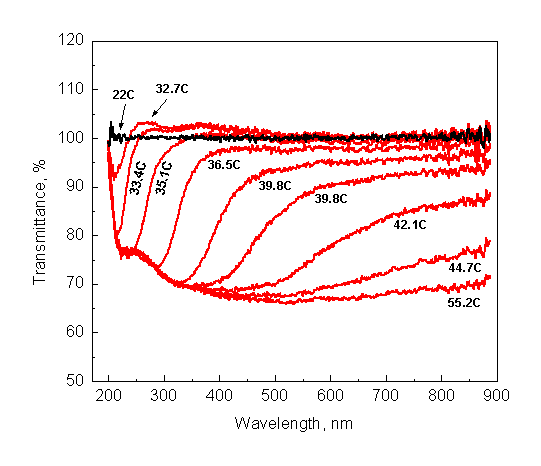

44161-GB5
Photopolymerization by Evanescent Waves and Spectroscopic Study of Mechanochemical Response of the Polymer Network on an Optical Fiber
Goal Statement. The ultimate goal of the research is to fabricate a cylindrical polymer network (hydrogel) on the side-surface (not the distal end) of an optical fiber core and characterize spectroscopically its swelling/de-swelling ability in response to different stimuli.
Year 1 brief summary. (1) Composition of the hydrogel forming solution, proper photoinitiator, and transmittance of fiber optics at the wavelength of light source were optimized using procedure for bulky-hydrogel preparation as a model. (2) A unique reactor-container was designed to control the polymerization process both spectroscopically and microscopically. (3) To study photopolymerization within microscopic volumes, the giant unilamellar vesicles (GUV, ~5-300 µm) have been used as soft microreactors. (4) Kinetics of proton intake has been studied in suspensions of artificial hydrogel particles of micrometer size (~20-200 µm) and natural gel-like multilayered structures (bacterial spores). (6) Three oral talks have been presented by the undergraduate students involved into these studies at 55th ACS Undergraduate Research Symposium (NY, May 2007).
Year 2 progress. Considerable efforts have been undertaken to work out a robust procedure for hard polymer cladding removal in order to make a side-open fiber core. Eventually, a method for reproducible fabrication of a cylindrical polymer network on a fiber core using polymerization by evanescent waves was developed (Figure 1). For example, the average thickness of the film after 2 hour polymerization has been estimated to be ~175 µm in wet state, ~60 µm after 6 hours of drying, and ~30 µm after overnight drying on air.
 |

Our results are of great potential for hydrogen storage on ion-sensitive polymer network. For the first time, gigantic proton capacity (average number of ionizable groups) and particular type of the binding sites (apparent binding constant) have been obtained for synthetic ionic reservoirs (hydrogels) and for ionic polymer networks uniformly fabricated by Nature (bacterial spores). It was shown that the plurality of steps comprising the uptake of protons inside spores may be attributed to their internal multi-layered microstructures.
Conclusions
and future perspectives.
It was demonstrated that an optical fiber with open side surface of its
core connected to a spectrometer is an apparatus for polymerization and
analytical device in one. A cylindrical polymer network itself is a
prerequisite for a supported 2D-single macromolecule with the world's highest and the record fastest
level of expansion and contraction (energy conversion). A light emitting
polymer, cross-linked around a fiber core, is a prerequisite for an optically
pumped organic laser Impact to the PI and students career. These
results on ionic reservoirs were published in Journal of Physical Chemistry and
NIST Nanotech 2008, presented at the following conferences: PITTCON 2008, MARM
2008, SIGMA-XI Students Research Society 2008, NANOTECH 2008, 236th ACS National Meeting. New results were
submitted to PITTCON 2009. Four oral talks have been presented by undergraduate
students involved in these studies at 56th Undergraduate Research
Symposium (NY, April 2008) and 27th Annual Meeting of The
Dyson Society of Fellows. The PI has been promoted to the rank of Associate
Professor in 2007 and received his tenure in 2008. The results were used to
complete the research grant application submitted to the NSF.